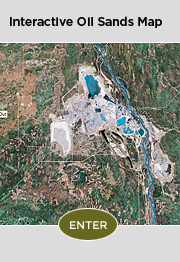In-Situ Extraction Method
Fact: In-situ techniques are generally used to recover bitumen that is more than 200 feet deep and where surface mining is not viable.
- Currenly, 20 per cent of Alberta’s total oil sands reserves are deemed to be mineable, the remaining 80 per cent can be accessed through in-situ techniques.
- In 2007, Alberta produced 243 million barrels of oil from the mineable oil sands and 196 million barrels from the in-situ areas. That means about 45 per cent of the oil from the oil sands came from in-situ operations.
Fact: In-situ technology is relatively new and has opened access to the majority of Alberta’s oil sands reserves.
- The potential value of in-situ oil sands development was recognized in 1974 when the Alberta Oil Sands Technology and Research Authority (AOSTRA) was created to research in-situ technologies.
- In 1985 commercial in-situ production began at Imperial Oil’s project in Cold Lake, Alberta.
- The per-barrel costs of in-situ production compares favourably with mining techniques.
Fact: The two in-situ techniques most commonly used in commercial projects today are cyclic steam stimulation (CSS) and steam assisted gravity drainage (SAGD).
- CSS injects steam into the oil reservoir to heat up the bitumen to make it flow more easily, allowing it to be brought to the surface. The steam condenses into water in the reservoir and the water is often recycled and then reused as steam.
- SAGD uses two horizontal pipes that are drilled into the oil sands formation. The top pipe injects steam into the formation to liquefy the bitumen allowing it to flow to a lower pipe that brings it to the surface.
Fact: There are several evolving in-situ methods of extraction that are aimed at improving environmental performance and increasing production.
- Vapour recovery extraction (VAPEX) is a method that uses solvents instead of heat and steam to make bitumen flow.
- Toe-to-heel air injection (THAI) is an in-situ process that relies on underground combustion rather than steam to warm the bitumen and make it flow. This method uses comparatively little water and emits fewer green house gases.
- Low pressure SAGD uses electric submersible pumps to reduce the amount of pressure that is needed from the steam to get the bitumen moving.
Fact: In-situ processes come with a specific set of challenges, which are being addressed.
- The main challenges facing in-situ producers are improving production rates and energy efficiency and reducing reliance on water.
- There have been dramatic improvements in water consumption over the last 20 years. In-situ facilities have progressed from using approximately 3.5 barrels of fresh water for every barrel of bitumen produced to using half a barrel of fresh water, a 600 per cent improvement. For the most part, water used to generate steam is drawn from underground aquifers, and operators use brackish/saline water which is unsuitable for human consumption. In-situ operators recycle up to 90 per cent of the water they use.
- It takes about 28 cubic metres (1,000 cubic feet) of natural gas to produce one barrel of bitumen from in-situ projects. Emerging technologies are aimed at reducing this level.
- Many in-situ producers install cogeneration units to produce steam and generate electricity. Many projects produce enough electricity to be self-sufficient and the potential exists to send excess energy to the power pool.
Facts sourced by Oil Sands Developers Group (October 2009).
Sources for all facts available upon request.




















